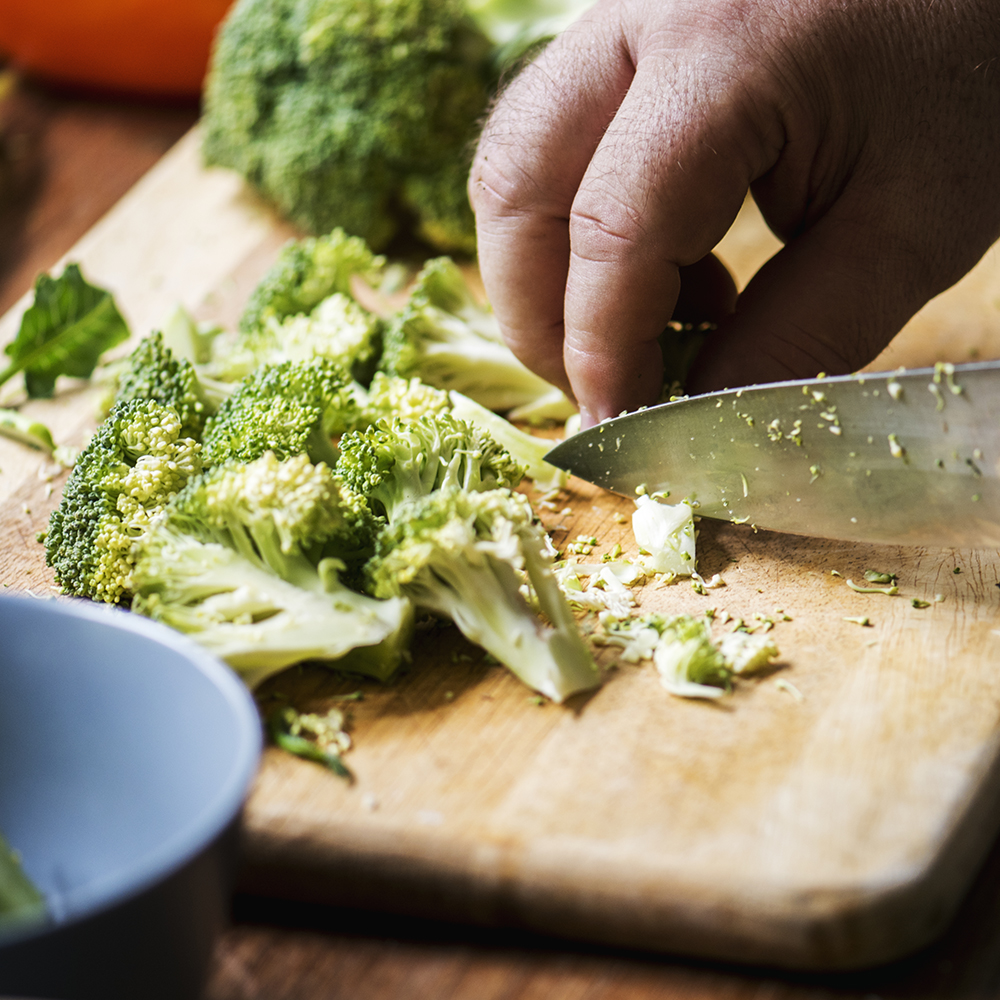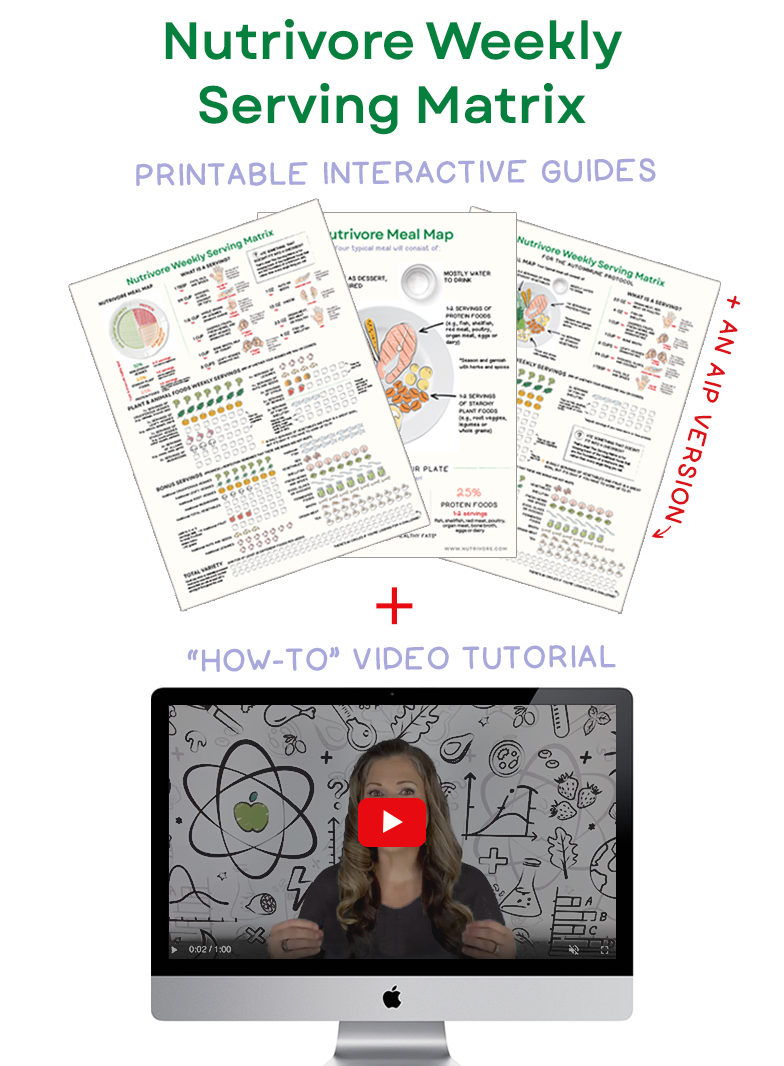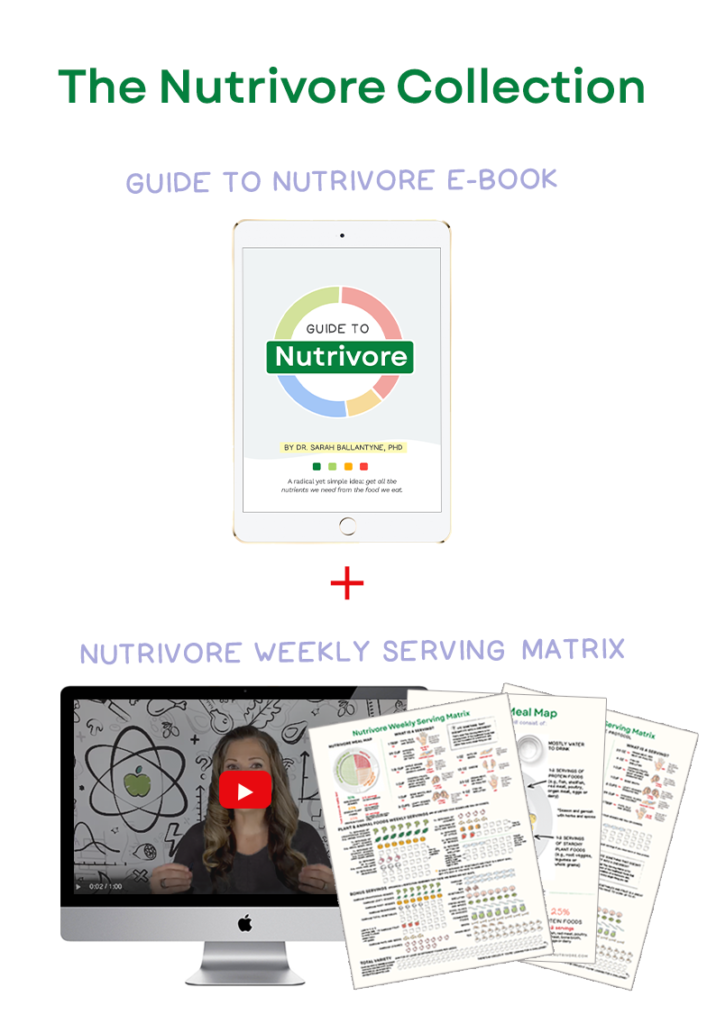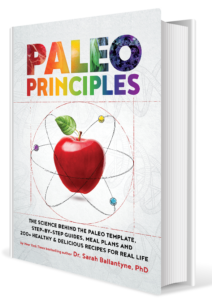 Cruciferous vegetables are members of the Brassicaceae family, many of which are actually cultivars of a single species (Brassica oleracea): cabbage, Savoy cabbage, cauliflower, broccoli, Brussels sprouts, collard greens, kohlrabi, gai lan, and kale! Additional crucifers include cultivars of Brassica rapa (turnips, napa cabbage, bok choy, and rapini), horseradish, watercress, garden cress, radish, daikon, collard greens, rutabaga, and mustard greens. The term “cruciferous” comes from the Latin cruciferae, which means “cross-bearing” and refers to the shape of these plants’ flowers.
Cruciferous vegetables are members of the Brassicaceae family, many of which are actually cultivars of a single species (Brassica oleracea): cabbage, Savoy cabbage, cauliflower, broccoli, Brussels sprouts, collard greens, kohlrabi, gai lan, and kale! Additional crucifers include cultivars of Brassica rapa (turnips, napa cabbage, bok choy, and rapini), horseradish, watercress, garden cress, radish, daikon, collard greens, rutabaga, and mustard greens. The term “cruciferous” comes from the Latin cruciferae, which means “cross-bearing” and refers to the shape of these plants’ flowers.
Cruciferous Veggies Are Nutrient Superstars!
Although crucifers encompass a diverse list of vegetables, every one of them is packed with nutrition! These vegetables tend to be high in fiber, folate, and vitamin K (with leafy green crucifers also being high in vitamin C and carotenoids), but vary in their exact nutritional profile. For example:
- One cup of cooked collard greens contains 50 calories, 5.3 g of fiber, over 1000% of the DV for vitamin K, over 300% of the DV from vitamin A (in the form of vitamin A precursors, see Genes to Know About: Vitamin A Conversion Genes), and about half the DV for folate, vitamin C, and manganese.
- One cup of chopped broccoli contains 31 calories, 2.4 g of fiber, and over 100% of the DV for vitamin C and vitamin K, along with substantial manganese and folate.
- One cup of chopped cabbage contains 22 calories, 2.2 g of fiber, 85% of the DV for vitamin K, over half the DV for vitamin C, and notable folate.
- One cup of cooked Brussels sprouts contains 56 calories, 4 g of fiber, almost 300% of the DV for vitamin K, 160% of the DV for vitamin C, and substantial vitamin A, folate, vitamin B6, potassium, and manganese.
Yep, every cruciferous veggie is a very nutrient-dense food!
But, perhaps even more impressive than their micronutrients is the array of phytonutrients that crucifers are famous for (see also The Amazing World of Plant Phytochemicals: Why a diet rich in veggies is so important!, Polyphenols: Magic Bullet or Health Hype?, and The Link Between Meat and Cancer).
Along with chlorophyll, carotenoids, and flavonoids, these vegetables are rich in sulfur-containing compounds called glucosinolates, which break down into bioactive isothiocyanates when the vegetables are damaged (via chewing, cutting, or other processing). (Although it was previously believed that glucosinolates could be problematic for people with thyroid disease due to their goitrogenic properties, recent studies show this to be untrue; for a detailed analysis, see Cruciferous Vegetables and Thyroid Disease.) Isothiocyanates are absolute rock stars as far as human health is concerned! Research spanning human epidemiology, animal models, and in vitro experiments show that dietary isothiocyanates are inversely associated with bladder cancer, lung cancer, colon cancer, breast cancer, and pancreatic cancer; some evidence also suggests they may be able to improve ventricular function following heart attacks.
Health Benefits of Cruciferous Veggies
More broadly, cruciferous vegetable consumption has been associated with lower risk of all-cause mortality (a general measurement of health and longevity) and cardiovascular disease mortality. A pooled analysis of the Shanghai Women’s Health Study and Shanghai Men’s Health Study (encompassing 134,796 adults) found a 22% reduced risk for total mortality and 31% reduced risk for cardiovascular disease mortality among individuals with the highest intake of cruciferous vegetables. A variety of prospective cohort and case-control studies have likewise found that overall cruciferous vegetable consumption is associated with lower risk of bladder cancer (up to a 20% lower risk), breast cancer (up to a 15% lower risk), colorectal cancer (up to an 18% lower risk), endometrial cancer (up to a 21% lower risk), gastric cancer (up to a 19% lower risk), lung cancer (up to a 25% lower risk), ovarian cancer (up to an 11% lower risk), pancreatic cancer (up to a 21% lower risk), prostate cancer (up to a 10% lower risk), and liver cancer (up to a 27% lower risk). One human trial also found that eating a high-cruciferous-vegetable diet reduced some markers of inflammation (particularly the inflammatory cytokine interleukin-6 [IL-6]).
Individual cruciferous veggies have also been linked to specific health benefits.
For example, in a prospective study of 29,361 men, cauliflower appeared more protective against prostate cancer than any other single fruit or vegetable (a 52% lower risk for people eating at least one serving per week, compared to under one serving per month). In one study, eating two cups of Brussels sprouts per day significantly protected cells against damage from oxidative stress; Brussels sprouts have also been shown to increase levels of detoxification enzymes and protect against carcinogens.
Likewise, broccoli and broccoli sprouts are high in a compound called glucoraphinin, which gets converted to sulforaphane—a powerful antioxidant—during digestion. Sulforaphane has been studied for its ability to halt cancer cell growth, kill cancer cells, upregulate a number of phase II detoxification enzymes, and protect healthy cells from damage from environmental carcinogens. Broccoli also contains the phytochemical glucobrassicin, which produces indole-3-carbinol when broken down (this compound also has been shown to cause cancer cell death and cell cycle arrest, along with altering estrogen metabolism). In studies, broccoli consumption appears inversely associated with breast cancer risk in humans, can lower LDL cholesterol in people with mild or moderate cardiovascular disease risk, and also shows benefit in protecting against non-alcoholic fatty liver disease and liver cancer growth in mice.
In studies, broccoli consumption appears inversely associated with breast cancer risk in humans, can lower LDL cholesterol in people with mild or moderate cardiovascular disease risk, and also shows benefit in protecting against non-alcoholic fatty liver disease and liver cancer growth in mice.
Meanwhile, along with glucosinolates, cabbage contains zeaxanthin and lutein (antioxidants that can benefit eye health, reduce the risk of macular degeneration, and even support cognitive function and memory!), and red cabbage contains 36 different anthocyanins, which help create its vibrant pigment and have been shown to reduce cardiovascular disease risk. Cabbage also yields indole derivatives that play a major role in immune modulation. See also Covid-19 and the Gut
Nutrivore Weekly Serving Matrix
An easy-to-use and flexible weekly checklist
to help you maximize nutrient-density.
The Weekly Serving Matrix is very helpful! I’ve been eating along these lines but this really helps me know where to focus vs. which foods serve a more secondary role. It’s super helpful and has taken a lot of worry out of my meal planning. Thanks!
Jan
Meanwhile, kale is rich in the flavonoids quercetin and kaempferol, which have been extensively studied for their protective effects against cancer, heart disease, inflammation, and high blood pressure. When cooked, kale is also a rich source of the potent anti-cancer chemical indole. One study showed that ingesting 150 mL of kale juice daily for 12 weeks led to a significant drop in LDL and an enhancement of antioxidant systems!
Cruciferous Veggies and Gut Health
Crucifers also happen to be incredibly beneficial for gut health. In fact, many of their health benefits come specifically through the interplay of their fiber and phytonutrients with the gut microbiota.
For example, the cells of cruciferous veggies contain myrosinase (an enzyme that catalyzes glucosinolates into isothiocyanates, and that gets released when the plant cells are damaged), but this enzyme is heat-sensitive and becomes deactivated when vegetables are cooked above 60°C (meaning we may end up obtaining lower levels of isothiocyanates from cooked crucifers compared to raw). However, certain members of the human gut microbiota also have myrosinase-like activity and can metabolize glucosinolates into isothiocyanates. That means a healthy and diverse gut microbiota, with bacterial populations that secrete myrosinase, can help us obtain maximum health benefits from crucifers! In fact, this has been demonstrated in studies that manipulate the gut environment before ingesting glucosinolates: human trials have shown that urinary excretion of isothiocyanates decreases significantly when participants are first given antibiotics and bowel cleansing procedures, supporting the idea that our microbiota indeed works to degrade glucosinolates into their beneficial active byproducts. Several Lactobacillus and Enterococcus species, along with Bacillus cereus, Bacillus subtilis, Staphylococcus aureus, Bacteroides thetaiotamicron, some strains of Escherichia coli, and multiple Salmonella strains have all been identified for degrading glucosinolates into isothiocyanate.
 Trials of high-cruciferous-vegetable diets have shown that these vegetables can very quickly improve the state of our gut microbiota!
Trials of high-cruciferous-vegetable diets have shown that these vegetables can very quickly improve the state of our gut microbiota!
In one controlled crossover feeding study, subjects underwent several different two-week diets—including a control diet low in fiber and phytochemicals, and a diet rich in cruciferous vegetables (cauliflower, cabbage, broccoli, and radish sprouts). The results showed different microbiota responses to the high-cruciferous vegetable diet compared to the control, but also microbiota responses that were unique to each individual. In general, the bacteria Eubacterium hallii, Phascolarctobacterium faecium, Alistipes putredinis, and Eggerthella species were associated with cruciferous vegetable consumption, but the specific shifts in bacterial populations varied dramatically from person to person. The researchers speculated that these individual-specific responses were related to the baseline composition of the gut microbiota, or to the fact that bacteria species belonging to different phylogenetic groups could have the same metabolic functions (leading to a variety of different microbiota profiles emerging in response to compounds in cruciferous vegetables).
In another randomized crossover study, healthy adult participants spent two weeks eating a diet high in cruciferous vegetables (including broccoli and cauliflower), with a two-week washout period between the dietary phases. High intake of these vegetables was associated with a lower abundance of sulfate-reducing bacteria, along with a reduction in levels of bacteria belonging to Rikenellaceae, Ruminococcaceae, Mogibacteriaceae, Clostridium, and unclassified Clostridiales. The drop in sulfate-reducing bacteria is likely a good sign, because these microbes have been associated with ulcerative colitis and irritable bowel syndrome!
Some studies have also examined specific cruciferous vegetables in relation to gut health.
In rats, consumption of both raw and cooked broccoli for at least four days led to greater production of isothiocyanates, while also altering the microbiota composition in the cecum. And in a randomized, controlled, crossover feeding study in humans, healthy adults were fed either a control diet or a diet containing 200 g of cooked broccoli per day, over the span of two 18-day treatment periods. Broccoli consumption significantly increased the abundance of Bacteroidetes by 10%, decreased the abundance of Firmicutes by 9%, and increased the abundance of Bacteroides by 8% relative to the control. Intriguingly, the changes were the most dramatic among participants with BMIs greater than 26, and this group also demonstrated associations between relative bacterial abundance and glucosinolate metabolites. Further analysis showed that broccoli consumption increased the pathways involved in endocrine system function, transport and catabolism, and energy metabolism.
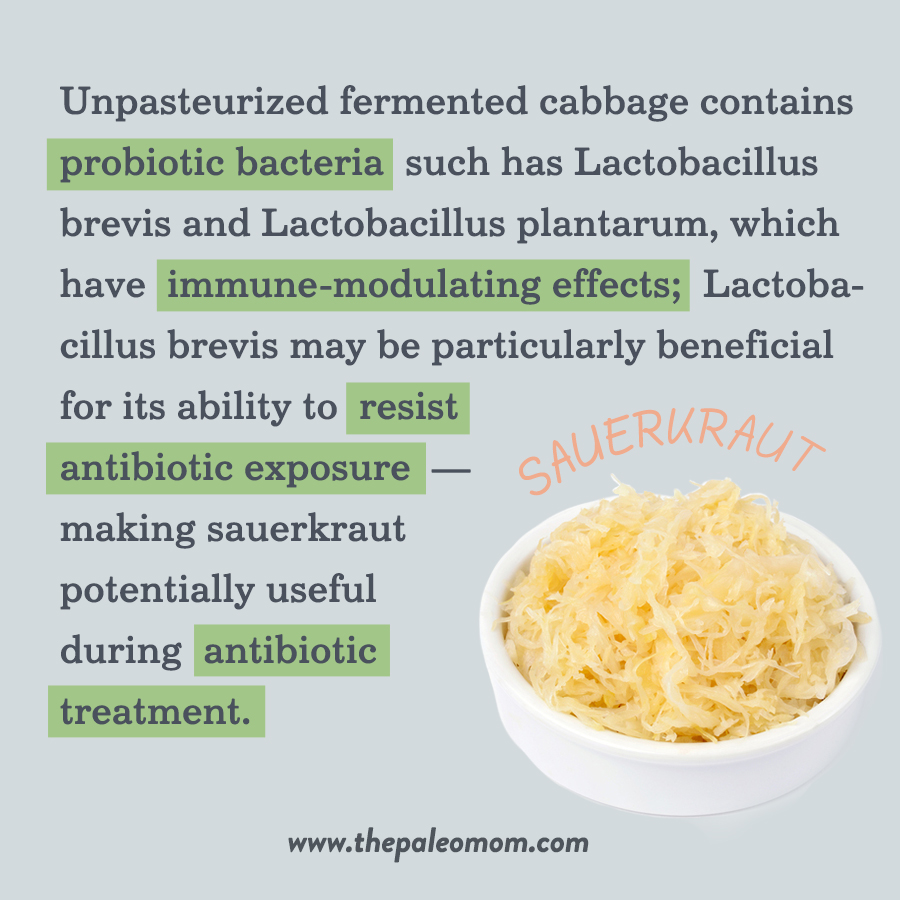 Fermented cabbage (including in the form of sauerkraut or kimchi) also has a unique set of gut health benefits above and beyond regular cabbage. Unpasteurized fermented cabbage contains probiotic bacteria such as Lactobacillus brevis and Lactobacillus plantarum, which have immune-modulating effects; Lactobacillus brevis may be particularly beneficial for its ability to resist antibiotic exposure—making sauerkraut potentially useful during antibiotic treatment.
Fermented cabbage (including in the form of sauerkraut or kimchi) also has a unique set of gut health benefits above and beyond regular cabbage. Unpasteurized fermented cabbage contains probiotic bacteria such as Lactobacillus brevis and Lactobacillus plantarum, which have immune-modulating effects; Lactobacillus brevis may be particularly beneficial for its ability to resist antibiotic exposure—making sauerkraut potentially useful during antibiotic treatment.
In rats with human-associated microbiota, four weeks of daily Brussels sprouts consumption led to higher levels of the SCFAs butyrate and acetate. Likewise, kaempferol, one of the polyphenols in Brussels sprouts, has been shown to modulate the gut microbiota in ways that exert anti-arthritis activity (more specifically, by normalizing levels of bacteria that had been dysregulated in mice with collagen-induced arthritis, namely Lachnospiraceae, Prevotellaceae, Bacteroidales_S24-7 group, Alcaligenaceae, Staphylococcaceae, and Erysipelotrichaceae).
Cruciferous Veggies for the Win!
The bottom line? Cruciferous veggies win no matter which way we slice them! Eating a variety of foods from this important group daily can support the health of our gut and beyond. Is it better to eat them raw or cooked? I answer that question in Is It Better to Eat Veggies Raw or Cooked?, but the quick answer is both are good but have a different impact on the gut microbiome, so it’s best to mix it up!
Here’s a handy-dandy list of cruciferous veggies:
- arugula (also known as rocket)
- bok choy
- broccoli
- broccoli rabe
- broccoflower
- broccoli Romanesco
- Brussels sprouts
- cabbage
- canola (also known as rapeseed)
- cauliflower
- Chinese broccoli
- collard greens
- daikon
- field pepperweed
- flowering cabbage
- garden cress
- horseradish
- kale
- kohlrabi
- komatsuna
- land cress
- maca
- mizuna
- mustard
- radishes
- rapini (also known as broccoli rabe)
- rutabaga
- tatsoi
- turnips
- wasabi
- watercress
- wild broccoli
Citations
Aa L-X, et al. “Rebalancing of the gut flora and microbial metabolism is responsible for the anti-arthritis effect of kaempferol.” Acta Pharmacologica Sinica 2020; 41: 73-81.
Ambrosone CB, et al. “Breast cancer risk in premenopausal women is inversely associated with consumption of broccoli, a source of isothiocyanates, but is not modified by GST genotype.” J Nutr. 2004 May;134(5):1134-8. doi: 10.1093/jn/134.5.1134
Bandera EV, et al. “Fruits and vegetables and endometrial cancer risk: a systematic literature review and meta-analysis.” Nutr Cancer. 2007;58(1):6-21. doi: 10.1080/01635580701307929.
Chen Y-J, et al. “Dietary Broccoli Lessens Development of Fatty Liver and Liver Cancer in Mice Given Diethylnitrosamine and Fed a Western or Control Diet.” The Journal of Nutrition, Volume 146, Issue 3, March 2016, Pages 542–550. https://doi.org/10.3945/j
Higdon JV, et al. “Cruciferous vegetables and human cancer risk: epidemiologic evidence and mechanistic basis.” Pharmacol Res. 2007 Mar;55(3):224-36. doi: 10.1016/j.phrs.2007.01.009. Epub 2007 Jan 25.
Hoelzl C, et al. “Consumption of Brussels sprouts protects peripheral human lymphocytes against 2-amino-1-methyl-6-phenylimidazo[4,5-b]pyridine (PhIP) and oxidative DNA-damage: results of a controlled human intervention trial.” Mol Nutr Food Res. 2008 Mar;52(3):330-41. doi: 10.1002/mnfr.200700406.
Hu J, et al. “Intake of cruciferous vegetables is associated with reduced risk of ovarian cancer: a meta-analysis.” Asia Pac J Clin Nutr. 2015;24(1):101-9. doi: 10.6133/apjcn.2015.24.1.22.
Humblot C, et al. “Brussels sprouts, inulin and fermented milk alter the faecal microbiota of human microbiota-associated rats as shown by PCR-temporal temperature gradient gel electrophoresis using universal, Lactobacillus and Bifidobacterium 16S rRNA gene primers.” Br J Nutr. 2005 May;93(5):677-84. doi: 10.1079/bjn20051372.
Jeffery EH & Araya M. “Physiological effects of broccoli consumption.” Phytochem Rev. 2009 Jul; 8, 283–298. doi: 10.1007/s11101-008-9106-4.
Jiang X, et al. “Chemopreventive activity of sulforaphane.” Drug Des Devel Ther. 2018 Sep 11;12:2905-2913. doi: 10.2147/DDDT.S100534. eCollection 2018.
Kaczmarek JL, et al. “Broccoli consumption affects the human gastrointestinal microbiota.” J Nutr Biochem. 2019 Jan;63:27-34. doi: 10.1016/j.jnutbio.2018.09.015. Epub 2018 Sep 21.
Kellingray L, et al. “Consumption of a diet rich in Brassica vegetables is associated with a reduced abundance of sulphate-reducing bacteria: A randomised crossover study.” Mol Nutr Food Res. 2017 Sep;61(9):1600992. doi: 10.1002/mnfr.201600992. Epub 2017 Apr 12.
Kim SY, et al. “Kale juice improves coronary artery disease risk factors in hypercholesterolemic men.” Biomed Environ Sci. 2008 Apr;21(2):91-7. doi: 10.1016/S0895-3988(08)60012-4.
Kirsh VA, et al. “Prospective study of fruit and vegetable intake and risk of prostate cancer.” J Natl Cancer Inst. 2007 Aug 1;99(15):1200-9. doi: 10.1093/jnci/djm065. Epub 2007 Jul 24.
Larson AJ, et al. “Therapeutic potential of quercetin to decrease blood pressure: review of efficacy and mechanisms.” Adv Nutr. 2012 Jan;3(1):39-46. doi: 10.3945/an.111.001271. Epub 2012 Jan 5.
Li F, et al. “Human gut bacterial communities are altered by addition of cruciferous vegetables to a controlled fruit- and vegetable-free diet.” J Nutr. 2009 Sep;139(9):1685-91. doi: 10.3945/jn.109.108191. Epub 2009 Jul 29.
Li L-Y, et al. “Cruciferous vegetable consumption and the risk of pancreatic cancer: a meta-analysis.” World J Surg Oncol. 2015 Feb 12;13:44. doi: 10.1186/s12957-015-0454-4.
Liu B, et al. “Cruciferous vegetables intake and risk of prostate cancer: a meta-analysis.” Int J Urol. 2012 Feb;19(2):134-41. doi: 10.1111/j.1442-2042.2011.02906.x. Epub 2011 Nov 28.
Liu B, et al. “Cruciferous vegetables consumption and risk of renal cell carcinoma: a meta-analysis.” Nutr Cancer. 2013;65(5):668-76. doi: 10.1080/01635581.2013.795980.
Liu B, et al. “The association of cruciferous vegetables intake and risk of bladder cancer: a meta-analysis.” World J Urol. 2013 Feb;31(1):127-33. doi: 10.1007/s00345-012-0850-0. Epub 2012 Mar 6.
Liu X, et al. “Dietary Broccoli Alters Rat Cecal Microbiota to Improve Glucoraphanin Hydrolysis to Bioactive Isothiocyanates.” Nutrients. 2017 Mar 10;9(3):262. doi: 10.3390/nu9030262.
Liu X & Lv K. “Cruciferous vegetables intake is inversely associated with risk of breast cancer: a meta-analysis.” Breast. 2013 Jun;22(3):309-13. doi: 10.1016/j.breast.2012.07.013.
Navarro SL, et al. “Cruciferous vegetables have variable effects on biomarkers of systemic inflammation in a randomized controlled trial in healthy young adults.” J Nutr. 2014 Nov;144(11):1850-7. doi: 10.3945/jn.114.197434. Epub 2014 Aug 27.
Nielsen ES, et al. “Lacto-fermented sauerkraut improves symptoms in IBS patients independent of product pasteurisation – a pilot study.” Food Funct. 2018 Oct 17;9(10):5323-5335. doi: 10.1039/c8fo00968f.
Thavarajah D, et al. “Mineral micronutrient and prebiotic carbohydrate profiles of USA-grown kale (Brassica oleracea L. var. acephala).” Journal of Food Composition and Analysis. 2016 Sep; 52: 9-15.
Tian S, et al. “Microbiota: a mediator to transform glucosinolate precursors in cruciferous vegetables to the active isothiocyanates.” J Sci Food Agric. 2018 Mar;98(4):1255-1260. doi: 10.1002/jsfa.8654. Epub 2017 Oct 9.
Verhagen H, et al. “Reduction of oxidative DNA-damage in humans by brussels sprouts.” Carcinogenesis. 1995 Apr;16(4):969-70. doi: 10.1093/carcin/16.4.969.
Wallace TC, et al. “Anthocyanins in cardiovascular disease.” Adv Nutr. 2011 Jan;2(1):1-7. doi: 10.3945/an.110.000042. Epub 2011 Jan 10.
Wang C-Y, et al. “Probiotic properties of Lactobacillus strains isolated from the feces of breast-fed infants and Taiwanese pickled cabbage.” Anaerobe. 2010 Dec;16(6):578-85. doi: 10.1016/j.anaerobe.2010.10.003. Epub 2010 Oct 15.
Wang P-Y, et al. “Higher intake of fruits, vegetables or their fiber reduces the risk of type 2 diabetes: A meta-analysis.” J Diabetes Investig. 2016 Jan;7(1):56-69. doi: 10.1111/jdi.12376. Epub 2015 Jun 22.
Wu Q, et al. “Cruciferous vegetables consumption and the risk of female lung cancer: a prospective study and a meta-analysis.” Ann Oncol. 2013 Jul;24(7):1918-1924. doi: 10.1093/annonc/mdt119. Epub 2013 Apr 3.
Wu Q-J, et al. “Cruciferous vegetable consumption and gastric cancer risk: a meta-analysis of epidemiological studies.” Cancer Sci. 2013 Aug;104(8):1067-73. doi: 10.1111/cas.12195. Epub 2013 Jun 21.
Wu QJ, et al. “Cruciferous vegetables intake and the risk of colorectal cancer: a meta-analysis of observational studies.” Ann Oncol. 2013 Apr;24(4):1079-87. doi: 10.1093/annonc/mds601. Epub 2012 Dec 4.
Zabat MA, et al. “Microbial Community Analysis of Sauerkraut Fermentation Reveals a Stable and Rapidly Established Community.” Foods. 2018 May 12;7(5):77. doi: 10.3390/foods7050077.
Zhang X, et al. “Cruciferous vegetable consumption is associated with a reduced risk of total and cardiovascular disease mortality.” Am J Clin Nutr. 2011 Jul; 94(1): 240–246.


